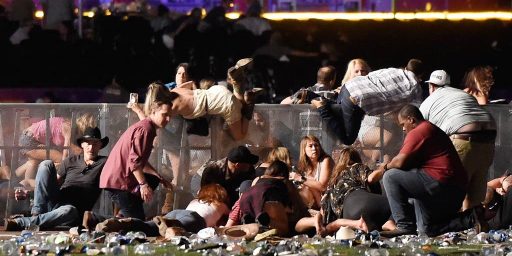Sin City Security
Via e-mail comes a very long article from Baseline entitled, “What Sin City Can Teach Tom Ridge.”
For decades, no city has attracted more dubious characters into its buildings than Las Vegas. The lure of quick scores has made Sin City the most vigilant and diligent user of advanced surveillance, identification, background-checking and security technologies. If domestic security were prosecuted as aggressively as casino security, the terrorists that took down the World Trade Center towers might well have been caught. After all, several of them were in Las Vegas as late as August 2001. Here’s what Tom Ridge and counterparts still could learn.
***
In the effort to prevent future attacks, the U.S. Department of Homeland Security (DHS) and other federal and local law enforcement agencies are now beginning to deploy the kinds of transactional, facial and other tracking technologies that casinos such as the MGM Grand, the Venetian, the Bellagio and the Stratosphere long have used.
By combining basic information on employees and guests, such as their stated home addresses, the purchases they make, the times they visit town and the movements they make, these casinos have created enormous databases that show not only visitors’ playing habits, but their criminal pasts and their connections to other visitors. All to safeguard a $70-billion-a-year gaming and resort industry.
Sure, these casinos use state-of-the-art digital and analog surveillance cameras and equipment to watch the activities of patrons and employees as they move or stop in any given square foot of their property. But they also make use of seemingly innocuous sources of data, such as the card keys guests use to open their rooms or the charges they make at gift shops, to paint a picture of “non-obvious” clues that might reveal unexpected threats to their tills—and their facilities.
By combining decades-old security procedures with these new tools, Las Vegas, despite being the fastest growing metropolitan area in the United States in the past dozen years, recorded in 2001 the fewest crimes per thousand residents (40.5) of any U.S. city with a population of more than 1 million residents, according to the Federal Bureau of Investigation. By comparison, on average, a city of that size reported 77 crimes per 1,000 residents.
Much of this looks reasonably promising, although the practicality–let alone the desirability–of applying the level of scrutiny possible within a casino complex to the entire country is questionable. Still, the article is worth a read-through. If nothing else, it’ll make you a little leery of going to Las Vegas if you have any desire for privacy.





I’ve begun to go after information in this manner:
* With people that may be indifferent to my subject matter, I use my blog name, which easily sounds like a publication.
* With people that I may be writing about to spoof, or would find my content objectionable, I simply say that I am a freelance writer.
The freelance angle can work well.
—